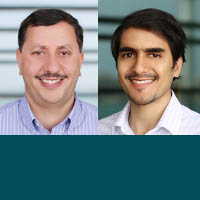Material Science and Engineering
A crystal clear step closer to commercial solar cells
Record-breaking, high-efficiency single crystals bring perovskite solar cells closer to market.

A synthetic approach developed by KAUST researchers generates homogeneous and defect-free crystals that could fast-track the commercialization of perovskite solar cells.
“Perovskite solar cells are the fastest developing type of photovoltaic technology, with power-conversion efficiencies rising from 3.8 percent in 2009 to 24.2 percent in 2019 for single-junction devices,” says Osman Bakr, who led the study with Omar Mohammed. This rapid increase in performance is associated with inexpensive and simple device fabrication, which makes these solar cells commercially appealing.
With 21.09 percent photon current efficiency (PCE), KAUST has now achieved the highest power-conversion efficiency for single-crystal perovskite solar cells since similar work began in 2016. Modified with permission from reference 1 © 2019 American Chemical Society
The performance and stability of solar cells depend on the morphology of the perovskite thin films, which act as light-harvesting layers in the devices. As well as their low cost and easy processing, these materials have exceptional optical and transport properties. Hybrid lead-based perovskites that combine a methylammonium cation with several halides, such as the anionic forms of bromine and iodine, present a narrow and tunable optical bandgap. This bandgap nears the theoretical value required to reach the maximum conversion efficiency for a single-junction solar cell. Therefore, perovskites could become a substitute of choice for silicon-based solar materials.
However, existing perovskite solar cells usually consist of polycrystalline thin films that are highly disordered and defective, which prevents devices from achieving optimal performance.
To address this issue, Bakr and Mohammed have now produced high-aspect-ratio, single-crystal films of methylammonium lead-triiodide perovskites. They achieved this by starting the crystallization between two polymer-coated substrates that would then physically restrict crystal growth to one dimension under heating.
Compared with their polycrystalline counterparts, single-crystal perovskites display substantially lower defect density and much higher charge-carrier diffusion lengths: this is a measure of their ability to maintain light-generated electrons separate from positively charged holes and create electrical current. Therefore, “We reasoned that these single crystals offer a chance for perovskite solar-cell technology to overcome these limitations and get as close as possible to the theoretical efficiency limit,” Mohammed says.

A photo and schematic of the single-crystal perovskite solar cell developed by KAUST.
Modified with permission from reference 1 © 2019 American Chemical Society
The crystals, which exhibited a thickness of 20 micrometers and an area of several square millimeters, provided high-quality solar cells with a maximum power-conversion efficiency of 21.09 percent. These devices set a new performance record for perovskite single-crystal solar cells.

The current–voltage curves demonstrate the effectiveness of the solar cells in converting sunlight into electricity.
Modified with permission from reference 1 © 2019 American Chemical Society
“We were pleasantly surprised by these results,” Bakr says. He adds that the researchers initially thought that they would need to grow crystals much thinner than 20 micrometers to achieve this performance, and growing thin crystals is extremely challenging.
The researchers believe that this record efficiency highlights the potential role of single crystals in the development of perovskite-containing devices in parallel with the path taken by their polycrystalline counterparts.
References
-
Chen, Z., Turedi, B., Alsalloum, A., Yang, C., Zheng, X., Gereige, I., AlSaggaf, A., Mohammed, O.F. & Bakr, O.M. Single-crystal MAPbI3 perovskite solar cells exceeding 21% power conversion efficiency. ACS Energy Letters 4, 1258–1259 (2019).| article
You might also like

Applied Physics
A single additive enables long-life, high-voltage sodium batteries

Bioengineering
Smart patch detects allergies before symptoms strike

Applied Physics
Two-dimensional altermagnets could power waste heat recovery

Applied Physics
Interface engineering unlocks efficient, stable solar cells

Applied Physics
The right salt supercharges battery lifespan

Applied Physics
Light-powered ‘smart vision’ memories take a leap forward

Applied Physics
Natural polymer boosts solar cells

Material Science and Engineering




